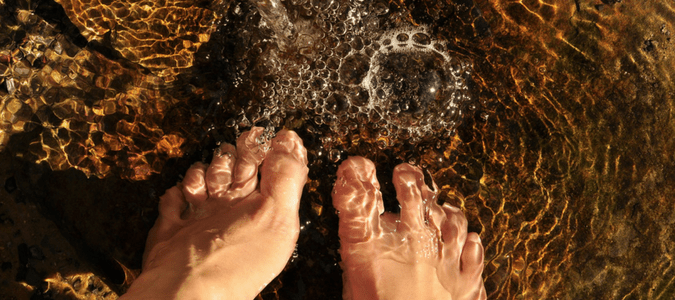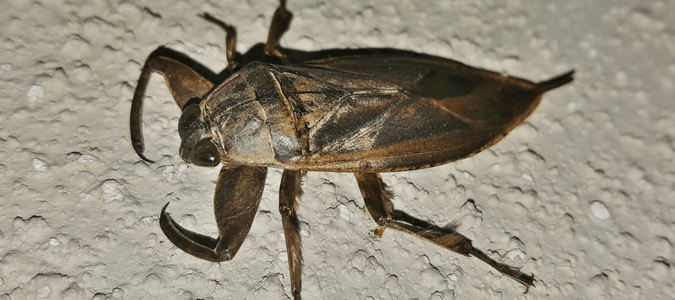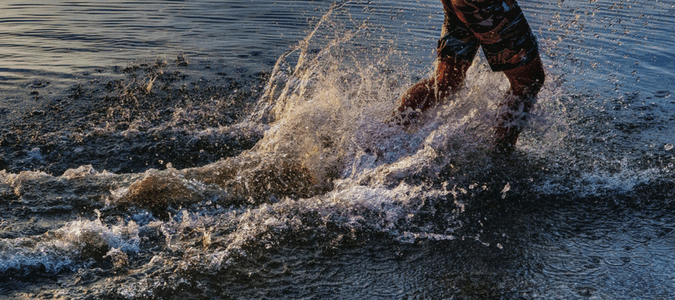
Imagine that you are taking your dog for a quick swim in the creek in the greenbelt in your neighborhood. By anyone’s standards, not a particularly dangerous activity. It’s the end of August, a great time for both of you to cool off from the oppressive heat.
You decide you might as well take off your shoes and dip your toes into the cool water.
Then it happens. One minute you were laughing and your pup was splashing around, and the next minute, you suddenly feel an intense pain in your toe, causing you to scream.
You look down, expecting to see a snake. Instead, you see a frighteningly huge bug swimming away. Was that a giant cockroach or beetle? You may even have a simpler question: do water bugs bite?
Immediately you pull on your dog’s leash and limp out of the water as you begin to feel the pain shooting up your foot and ankle. Safe (hopefully) on shore, you take a closer look at your foot. You see that your big toe is bleeding, and the pain isn’t getting any better.
What happened? Most likely, you ran afoul of the giant water bug. Although there are many bugs that live in both freshwater and ocean environments, giant water bugs are the species that can and do bite humans and are probably the biggest cause of concern.
Here in the South, these types of bugs are all over our waterways, especially (but not limited to) more rural areas. Below, we’ll tell you everything you need to know about these vicious freshwater predators, so you can identify them, treat water bug bites and do everything in your power to keep them as far away from you and your loved ones as possible.

What To Look For: Giant Water Bug Identification
The largest insect in the US and Canada, these amphibious creatures from the family Belostomatidae can grow to be up to four inches long and prey on everything from other bugs to crustaceans, fish and even snakes. In fact, the giant water bug can eat an animal 50 times its size–which would be the equivalent of a person eating an elephant in a single meal.
Since they go after a number of creatures that we consider pests, giant water bugs are actually considered by some to be beneficial, similar to our feelings about spiders. It helps that water bugs don’t consider us prey and mostly leave people alone.
Unless you handle them. Or startle one of these scary-looking animals, as was likely the case in the scenario we presented above.
Hence a common nickname for these insects: “toe-biters.” You might also hear giant water bugs called alligator ticks, alligator fleas and electric light bugs.
Mostly, giant water bugs tend to stick to the bottoms of freshwater lakes, rivers, and streams, though there have been a few cases of people being bitten in pools. Oh, and they’re attracted to electric lights and can fly, so it’s possible that one might mosey over to your porch if you’re sitting out at night during mating season.
Not exactly a comforting thought.
So how do you recognize giant water bugs in order to keep your distance?
You might remember that the person in the story compared the bug racing away to a big cockroach or beetle. That’s not a bad comparison, but there are distinct characteristics that differentiate giant water bugs from other, more familiar insects. If you are trying to determine what creature you are looking at, keep in mind that giant water bugs are:
Really big. This is an obvious telltale sign, right? As mentioned above, these intimidating bugs can grow to be up to four inches long, though those species of toe-biters mostly show up in South America. The North American varieties tend to only make it to about two and a half inches from end to end.
Long, flat, oval bodies. Not much more to say about this one. Water bug torsos are long, flat and oval-shaped.
Incredibly short antennae. In comparison with, say, roaches, which have long, thin antennae that reach straight out, it can look like giant water bugs don’t have antennae at all. They do, but they’re so short as to be almost invisible.
Big, pincerlike forelegs. The two front legs of the giant water bug are designed to help them grab and hang on to prey, so they look big and intimidating. Imagine an open pair of pliers that could snap shut around your toe or finger and you’ve got a pretty good idea.
Brown-black coloring. They’ve been described as looking like the color of dead leaves, which isn’t particularly comforting when you consider the fact that they are often most active at the end of summer and into the fall.
If you happen to notice an insect that looks like it could be a giant water bug, the best thing to do is stay away. This is true even if the creature appears to be dead, because they have been known to play possum to fool predators, then attack viciously when handled.

Are Water Bugs Poisonous?
When they bite, toe-biters inject a strong toxin that is designed to not only paralyze their prey, but also to liquify their internal organs. Ouch.
Thankfully, the toxin does not do this to people. However, the longer you allow a giant water bug to hang on and continue injecting its toxin:
- The worse and more widespread your pain will be.
- You increase the risk of permanent damage being done.
In short, yes, this bug is quite poisonous, though not in a life-threatening way like a rattlesnake. Most likely, a bite will cause little harm. As such, these creatures are classified as “harmless.”
Despite these huge bugs only being considered a nuisance, beyond intense pain, some people have been known to experience swelling, cramping, vomiting, fever and difficulty breathing after being bitten. If you suffer any of these issues, you definitely need to take the bite seriously and get help.

Giant Water Bug Bite Treatment: What Should You Do?
The first thing to know is that if you experience any of the more serious effects described above after being bitten by a giant water bug–fever, vomiting and so on–you absolutely need to get help from a medical professional. It is possible that you might be allergic, and you need a professional’s skills and knowledge to determine the best course of treatment.
Luckily, most people who experience a bite will not suffer these symptoms. If the worst thing you’re feeling is pain and maybe some swelling, you should be able to treat the injury yourself.
Here’s what you can do:
- Get the bug off you as quickly as possible. Remember, the longer a giant water bug stays latched on, the more toxin it will inject into you.
- Wash the affected area with soap and water. Make sure to really rub the soap over the wound and leave it on for several seconds after you work up a good lather. This will minimize itching and make infection less likely.
- Take an anti-inflammatory medicine, such as aspirin or ibuprofen.
- Apply an ice pack if you notice swelling.
- Wipe a cotton ball dipped in lemon juice, a paste of water and baking soda, or calamine lotion to lessen itching.
Generally speaking, pain and other symptoms should recede within several hours of being bitten, though unfortunately pain medications reportedly due little to make it go away faster. If you’re not feeling better after that time or, again, if you experience any of the more severe symptoms we described above, the best thing to do is to seek the help of a doctor.

How Bad Is It? The Giant Water Bug Bite Pain Scale
“Intense.” “Excruciating.” “Severe.” “One of the most painful [bites] that can be inflicted by any insect.”
Those are just a few of the words that have been used to describe how it feels to get bitten by a giant water bug.
But what exactly does that mean? Is there a pain scale or something to compare it to?
Perhaps the clearest comparison comes from Coyote Peterson in the show Breaking Trail. In one episode, the show host catches a giant water bug and then encourages it to bite him on camera by pressing it against his big toe.
His reaction is immediate and intense, as he yells out, hobbles around and then grabs his foot in apparent agony. But it’s his comment later on in the show that really gives you a sense of what the experience is like: he compares it to “dropping a brick on your toe.”
Even if you haven’t had the pleasure of being bitten by a giant water bug, it’s something most of us can pretty easily imagine…and would want to avoid.
How To Keep Giant Water Bugs Away
Knowing what toe-biters look like and where they tend to live can help you avoid them, but what if your property backs up to a greenbelt, has a pond or if near a river or creek and they’re already hanging around your property? Or you want to make sure they never do?
Here are some things you can do to discourage giant water bugs from sticking around near you and your loved ones:
Eliminate potential food sources. Toe-biters want to live near the types of creatures they eat. Remove those creatures and they have no reason to set up shop on your property.
Seal cracks and gaps. Giant water bugs mostly stay outside, but if they are getting into your home, they’re most likely doing so through a crack or gap in the wall, around a window, or near a door. Seal these holes up, and you can keep insects and other uninvited guests from getting in.
Removing water sources. They’re water bugs, so of course, these creatures need to be around places water collects. So, if you remove that water, there’s nowhere for them to stay. Most of the time this suggestion isn’t particularly helpful, because chances are you’re not going to want to remove a pond or swimming pool just to get rid of them. However, fixing leaks and getting rid of standing water can help in some situations.
Strategically placing traps. Water bug traps are one of the most effective ways to rid yourself of a problem, but it takes skill and experience to place the traps correctly and get to the source of the infestation.
ABC Can Help Solve Your Bug Problems
Giant water bugs are just one of the many insects and animals that can pose a problem to humans. Before trying to use traps on your own to control them on your property and potentially getting bitten, reach out to the professionals at ABC Home & Commercial Services. Our knowledgeable technicians can survey your property and suggest steps you can take to make your yard less attractive to water bugs and other uninvited guests. With ABC’s help, you can avoid suffering the pain and frustration of a bite and protect you and your family from other unwanted visitors.
